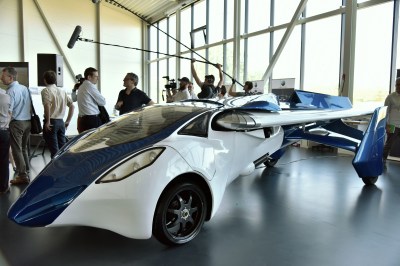
For almost as long as there have been cars and planes, people have speculated that one day we will all get around in flying cars. They’d allow us to “avoid the traffic” by flying through the air instead of sitting in snarling traffic jams on the ground.
The Klein Vision AirCar hopes to be just such a panacea to our modern traffic woes, serving as a transformable flying car that can both soar through the air and drive on the ground. Let’s take a look at the prototype vehicle’s achievements, and the inherent problems with the underlying flying car concept.
It Flies and Drives
The AirCar is a somewhat futuristic looking, yet simultaneously dated, vehicle. It’s a two-seater with a big bubble canopy for the driver and a single passenger. At the rear, there’s a propeller and twin-boom tail, while the folding wings tuck along either side of the vehicle in “car” mode. At the flick of a switch, the wings fold out and lock in place, while the tail extends further out to the rear. The conversion from driving mode to flight mode takes on the order of a few minutes. The powerplant at the heart of the vehicle is a 160-horsepower BMW engine which switches between driving the wheels and the propeller as needed.
Unlike some concepts we’ve explored in the past, the AirCar has successfully demonstrated itself as a working flying car without incident. Additionally, it did so as a single vehicular package, without removable wings or other such contrivances. On June 28th, 2021, it successfully flew from an airport in Nitra, Slovakia, down to the neighbouring city of Bratislava in 35 minutes – roughly half the time it takes by car. Company founder Stefan Klein was behind the controls, casually driving the vehicle downtown after the successful landing.

The successful flight is the culmination of decades of work. Klein’s first attempt at a flying car was the Aeromobil I back in 1989, which was more of a light aircraft than anything approximating a road vehicle. This was followed by Aeromobil II which developed the transformation concept based around folding wings but remained a conceptual build rather than a fully functional vehicle. AeroMobil 3.0 was built in 2014, and took to the skies before crashing on May 8 2015 after entering a spin. A ballistic parachute enabled Klein to survive the incident. Later, Klein went on to leave the Aeromobil company to start Klein Vision and develop the AirCar.
The AirCar does a lot of the obvious things right. The car body itself is shaped to generate lift, and everything that can be made lightweight is. The convertible wings and tail are really fun to watch as they fold in for driving mode.
So What’s The Problem?
A car with folding wings that can drive around town as well as take to the skies might seem like it’s solved the problem of the flying car once and for all. Unfortunately, this doesn’t take into account all the practical issues around the entire concept. There’s a reason major automakers have never put serious efforts into such technology, after all.

Building a car that can fly, fundamentally, is certainly doable, as the AirCar demonstrates. However, as the design shows, no new fancy technology was required to solve this problem. Thus, there must be some other reason we haven’t seen flying cars in great numbers already, and indeed there is.
While the AirCar may be called a “flying car”, more accurately, it is a plane that you can drive on the road. It still requires a pilot licence to fly, and it still requires the use of airports to take off and land. While air journeys may sometimes be faster on paper than the same journey by car, these analyses often completely ignore the significant administrative and logistical hurdles. Filing flight plans, running pre-flight checks, dealing with air traffic and securing a landing slot at a busy runway all take time which makes such journeys often slower than a car when everything is taken into account.
The simple matter remains that flying is hard. Keeping a car in between the dotted lines on the road is a task that many are able to handle, even if the road trauma statistics are higher than we might otherwise like. Controlling a plane, which can literally fall out of the sky if the pilot gets things wrong, is much harder, and carries much greater consequences. Multi-car crashes on the road are often survivable; air-to-air collisions are almost always fatal. Similarly, a poorly maintained car might leave its owner stranded and late for work. A poorly-maintained plane often leads to much more dire consequences.
In short, this isn’t the flying car for you, unless you’re already a light airplane pilot. This is much more a pilot’s car than it is a automobile driver’s airplane. But it’s also a snapshot of one man’s 30-year dream to make it a reality. And if you’re waiting to get your hands on one, they are taking orders, but if you have to ask how much it costs, you probably can’t afford it.
0 Commentaires